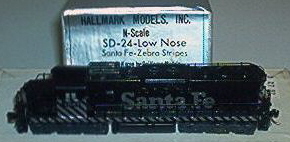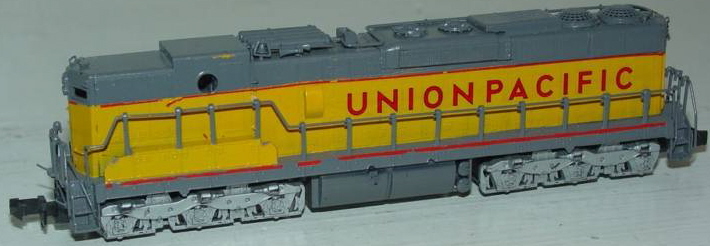SD26

SD24


SD26

SD24


Introduced: 1990
Everyone's always wondering why brass loco manufacturers don't just give up trying to make their own mechanisms and instead try mounting their pretty shells on somebody else's reliable, mass-manufactured chassis. Well, as it turns out, somebody did (once). Hallmark created these models using brass Dai Young shells mounted on Atlas/Kato SD7/9 mechanisms. They had open pilots and came with Rapido couplers (although, as pictured above, most of them have long since had their Rapidos converted to Micro-Trains couplers/pilots).
Although not DCC-Ready, the Kato chassis employs most of the other features one normally associates with "modern" Kato diesels - low-friction drive, split-frame metal chassis, dual-flywheels, plastic truck assemblies, plastic gearing, blackened wheels, all-wheel drive, and all-wheel pick-up (no traction tires). The motor is an open-sided 5-poler. Wheels are low-profile and have no problems on Code-55 track. To prevent short circuits, the chassis is provided with a vinyl cover at the factory. Unfortunately, this necessitated the removal of the dual lightboards normally found on this mechanism -

As one would expect, performance on these models is perfect in every way - smooth, quiet, flawless pickup and throttle response, exceptional pulling power, etc. As for looks? Well, there are issues...
According to legend, Hallmark had a lot of problems with these models. Although the samples they approved were beautiful, problems arose during production. Apparantly after Dai Young had built and painted them, they threw them into an oven to... cure the paint? Well, whatever the case, the oven went over temp and melted them all. So, they had to start over from scratch - and with mixed results. From what I've been told, it was the Union Pacific versions that got the worst of it. My Santa Fe SD24 (pictured above) has a decent enough paint job (to my eye anyway). However, I'm told that the paint on the UP models would literally peel off in your hands, and that some (if not all) of the graphics were simply decals. As a consequence, Hallmark ultimately had to lower the prices offered to their dealers because the quality was "below standard".
Another problem during the whole "repainting" fiasco arose when Dai-Young used the wrong paint scheme for the Santa Fe SD26 units. The actual prototypes were built from SD24s in 1973 and came out of the shops in the warbonnet scheme (and not the blue/yellow scheme used on these models).
High nose and B-Unit SD24's were also part of this release.


The shell is held on by nothing more than friction, so it should just slide up and off with a bit of finagling.
Grade: A (for performance). As for overall grade? I guess that would depend on the individual model and how the paint turned out.